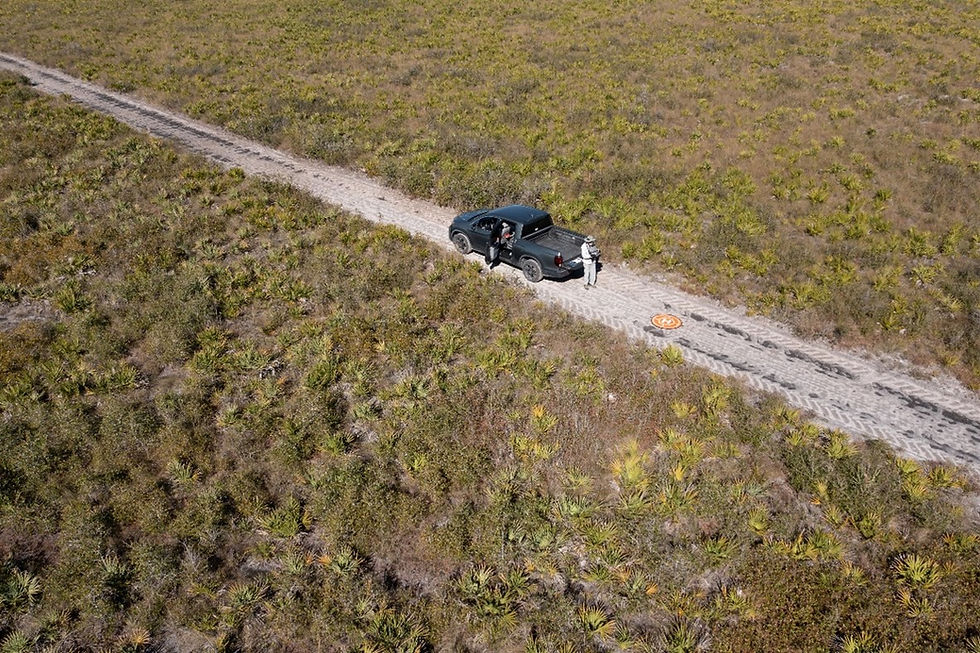Opossum Pipefish Re-introduction and Habitat Restoration in the St. Sebastian River
- Jeff Howe
- Oct 31
- 3 min read
The opossum pipefish (Microphis brachyurus) is one of several unique and rare freshwater fishes that inhabit a limited region of coastal Florida. Adult opossum pipefish reach a standard length of 200 mm, and it is the only Florida species in which the male bears a brood pouch on the trunk rather than on the tail. Adults are brown, allowing them to blend in with submerged and emergent aquatic vegetation.
Historically, most opossum pipefish have been collected in freshwater vegetated areas along the banks of the St. Sebastian River, in areas lacking overhanging shaded trees. An aquatic habitat comprised of emergent vegetation (e.g., smartweed, Persicaria hydropiperoides) and a variety of grasses provides the complex refugia necessary for both juveniles and adults. The complex vegetated habitat provides refugia from predation and an abundance of prey essential for rapid growth and maturation. In the past, the following fishes have been consistently captured in the same freshwater habitat as the opossum pipefish: fat snook, Centropomus parallelus and C. mexicanus; swordspine snook, C. enciferus; burrow grunt, Rhonciscus crocro, whitemouth croaker, Micropogonias furnieri; mountain mullet, Dajaous monticola; spiny-cheek sleeper, Eleotris pisonis/amblyopsis/perniger; bigmouth sleeper, Gobiomorus dormitor; river goby, Awaous banana; slashcheek goby, Ctenogobius pseudofasciatus; blotchcheek goby, C. fasciatus; violet goby, Gobioides broussonetii; crested goby, Lophogobius cyprinoides; and lyre goby, Evorthodus lyricus.
Opossum pipefish collected in Florida reveal that this species doesn’t need to migrate to the sea or nearshore estuarine waters and is reliant on freshwater habitats for reproduction and survival. Consequently, this species is vulnerable to human impacts on Florida’s freshwater ecosystems, including hydrological alterations, habitat loss, water quality degradation, the erection of barriers to inland migration, and the introduction of invasive and exotic species. Over the past several decades, the abundance and presence of opossum pipefish has dramatically declined.
The opossum pipefish is listed as a state species of special concern; however, it’s currently not federally listed as threatened or endangered under the Endangered Species Act (ESA). In collaboration with the Friends of the St. Sebastian River, Indian Riverkeeper, Estuarine, Coastal and Ocean Science researchers, and Indian River County Conservation Lands Division, Jeff Howe is assisting in writing a petition to submit to the U.S. Fish and Wildlife Service to formally request listing the opossum pipefish under the ESA. Our goal is to complete and submit the petition by the end of 2025 or early 2026.
In addition to the petition, a habitat restoration project along the bank of the St. Sebastian River adjacent to the Cypress Bend Conservation Area is in development. Based on historical records and current surveys conducted by drone and kayak, an approximate 100-meter section of shoreline has been identified for restoration. The restoration project will involve clearing the bank of all invasive vegetation and planting a variety of emergent and submerged aquatic plants to create suitable pipefish habitat. In addition to attracting naturally occurring pipefish, pipefish from reproducing populations in Lake Okeechobee will be relocated to the restored habitat. Also, we may investigate culturing pipefish in collaboration with local fish aquaculture facilities for restocking purposes. Lastly, an outreach component at the restoration area may consist of an observation deck and informational kiosk.
Hopefully, recognizing the interesting life history of the opossum pipefish and other fishes found in a similar habitat will stimulate and inspire their protection and the ecosystems on which they depend.





Comments